Recruitment, Selection, Development, and Retention in Organizations
VerifiedAdded on 2022/12/28
|10
|2546
|55
AI Summary
This document discusses the recruitment, selection, development, and retention strategies used by organizations. It explores the three approaches to recruitment - ethnocentric, polycentric, and geocentric staffing policies. The selection process, training and development, and employee retention programs are also discussed. Additionally, the document examines the role of organizational culture in shaping employee behavior and satisfaction. Examples from companies like Hitachi, Cisco, Tesla, ESDA, Sansberry, Infosys, and Apple are provided.
Contribute Materials
Your contribution can guide someone’s learning journey. Share your
documents today.

EXAM
Secure Best Marks with AI Grader
Need help grading? Try our AI Grader for instant feedback on your assignments.
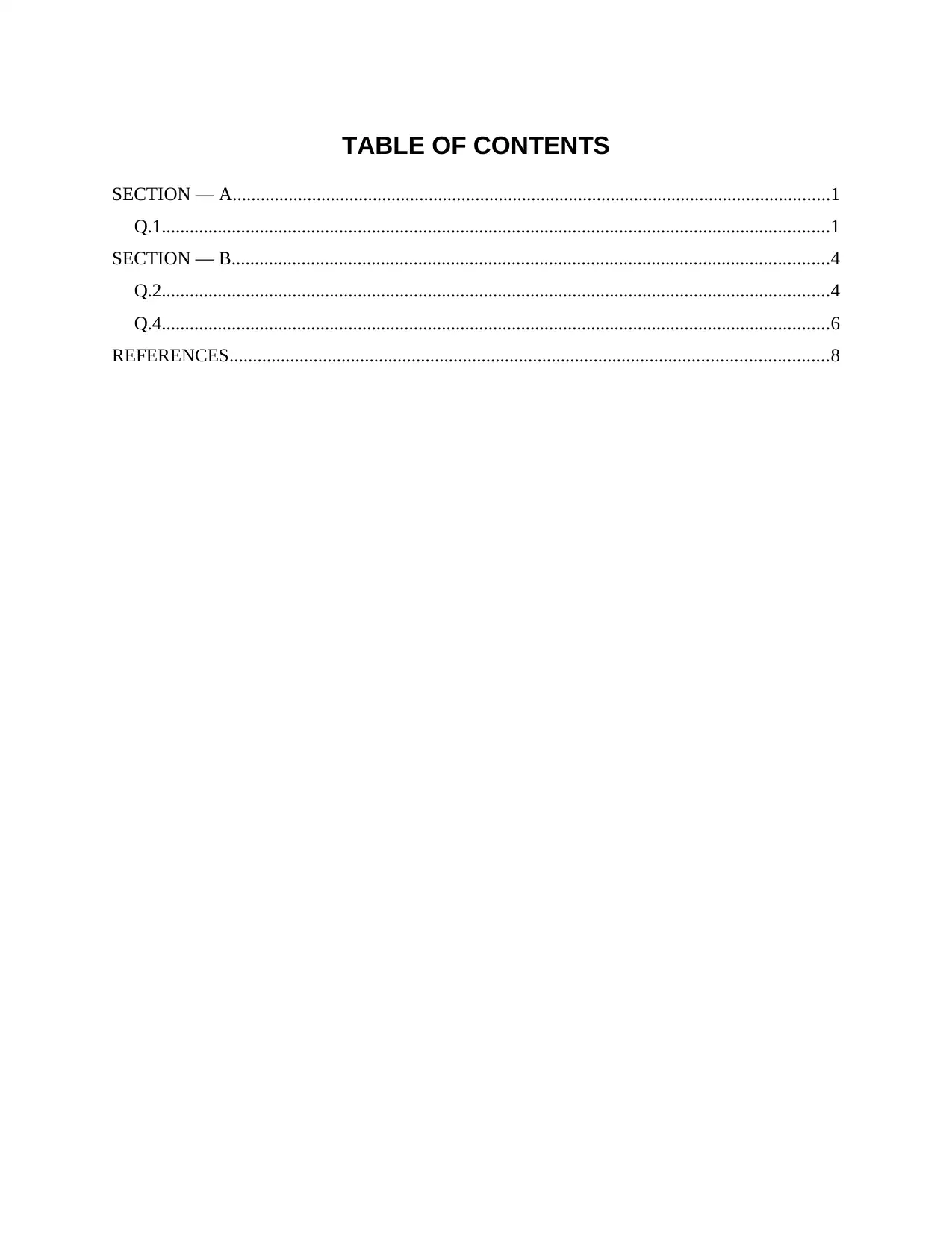
TABLE OF CONTENTS
SECTION — A................................................................................................................................1
Q.1...............................................................................................................................................1
SECTION — B................................................................................................................................4
Q.2...............................................................................................................................................4
Q.4...............................................................................................................................................6
REFERENCES................................................................................................................................8
SECTION — A................................................................................................................................1
Q.1...............................................................................................................................................1
SECTION — B................................................................................................................................4
Q.2...............................................................................................................................................4
Q.4...............................................................................................................................................6
REFERENCES................................................................................................................................8
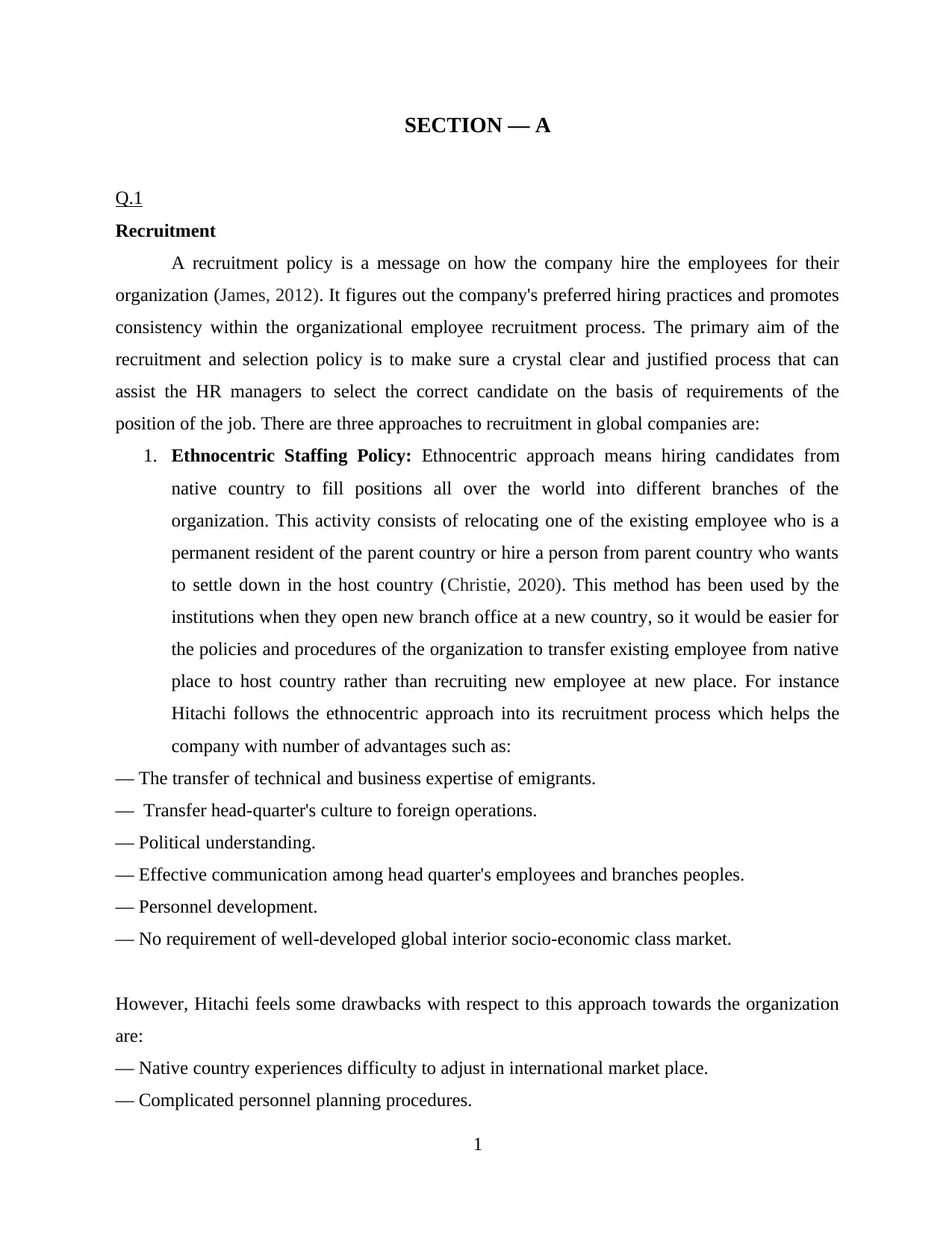
SECTION — A
Q.1
Recruitment
A recruitment policy is a message on how the company hire the employees for their
organization (James, 2012). It figures out the company's preferred hiring practices and promotes
consistency within the organizational employee recruitment process. The primary aim of the
recruitment and selection policy is to make sure a crystal clear and justified process that can
assist the HR managers to select the correct candidate on the basis of requirements of the
position of the job. There are three approaches to recruitment in global companies are:
1. Ethnocentric Staffing Policy: Ethnocentric approach means hiring candidates from
native country to fill positions all over the world into different branches of the
organization. This activity consists of relocating one of the existing employee who is a
permanent resident of the parent country or hire a person from parent country who wants
to settle down in the host country (Christie, 2020). This method has been used by the
institutions when they open new branch office at a new country, so it would be easier for
the policies and procedures of the organization to transfer existing employee from native
place to host country rather than recruiting new employee at new place. For instance
Hitachi follows the ethnocentric approach into its recruitment process which helps the
company with number of advantages such as:
— The transfer of technical and business expertise of emigrants.
— Transfer head-quarter's culture to foreign operations.
— Political understanding.
— Effective communication among head quarter's employees and branches peoples.
— Personnel development.
— No requirement of well-developed global interior socio-economic class market.
However, Hitachi feels some drawbacks with respect to this approach towards the organization
are:
— Native country experiences difficulty to adjust in international market place.
— Complicated personnel planning procedures.
1
Q.1
Recruitment
A recruitment policy is a message on how the company hire the employees for their
organization (James, 2012). It figures out the company's preferred hiring practices and promotes
consistency within the organizational employee recruitment process. The primary aim of the
recruitment and selection policy is to make sure a crystal clear and justified process that can
assist the HR managers to select the correct candidate on the basis of requirements of the
position of the job. There are three approaches to recruitment in global companies are:
1. Ethnocentric Staffing Policy: Ethnocentric approach means hiring candidates from
native country to fill positions all over the world into different branches of the
organization. This activity consists of relocating one of the existing employee who is a
permanent resident of the parent country or hire a person from parent country who wants
to settle down in the host country (Christie, 2020). This method has been used by the
institutions when they open new branch office at a new country, so it would be easier for
the policies and procedures of the organization to transfer existing employee from native
place to host country rather than recruiting new employee at new place. For instance
Hitachi follows the ethnocentric approach into its recruitment process which helps the
company with number of advantages such as:
— The transfer of technical and business expertise of emigrants.
— Transfer head-quarter's culture to foreign operations.
— Political understanding.
— Effective communication among head quarter's employees and branches peoples.
— Personnel development.
— No requirement of well-developed global interior socio-economic class market.
However, Hitachi feels some drawbacks with respect to this approach towards the organization
are:
— Native country experiences difficulty to adjust in international market place.
— Complicated personnel planning procedures.
1
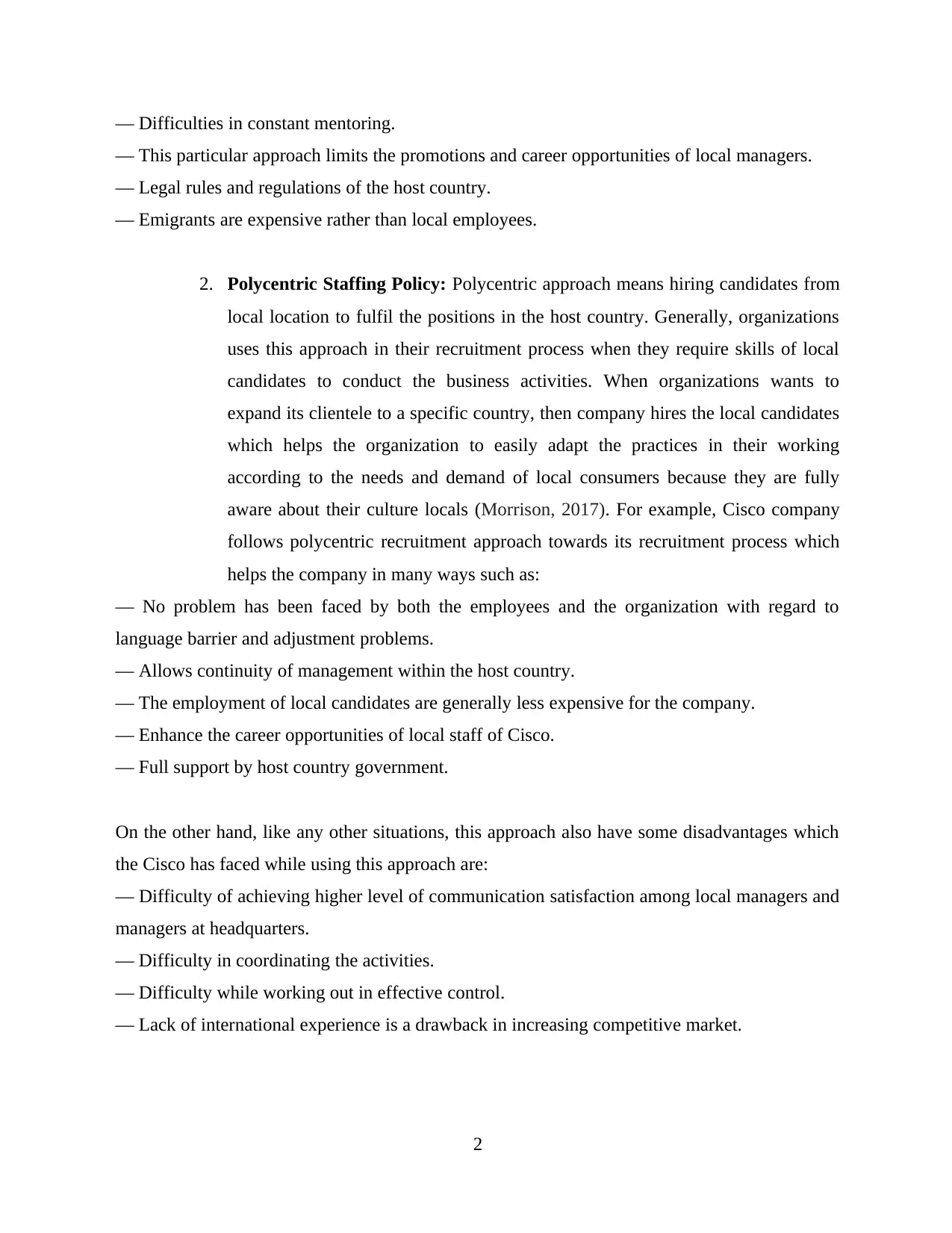
— Difficulties in constant mentoring.
— This particular approach limits the promotions and career opportunities of local managers.
— Legal rules and regulations of the host country.
— Emigrants are expensive rather than local employees.
2. Polycentric Staffing Policy: Polycentric approach means hiring candidates from
local location to fulfil the positions in the host country. Generally, organizations
uses this approach in their recruitment process when they require skills of local
candidates to conduct the business activities. When organizations wants to
expand its clientele to a specific country, then company hires the local candidates
which helps the organization to easily adapt the practices in their working
according to the needs and demand of local consumers because they are fully
aware about their culture locals (Morrison, 2017). For example, Cisco company
follows polycentric recruitment approach towards its recruitment process which
helps the company in many ways such as:
— No problem has been faced by both the employees and the organization with regard to
language barrier and adjustment problems.
— Allows continuity of management within the host country.
— The employment of local candidates are generally less expensive for the company.
— Enhance the career opportunities of local staff of Cisco.
— Full support by host country government.
On the other hand, like any other situations, this approach also have some disadvantages which
the Cisco has faced while using this approach are:
— Difficulty of achieving higher level of communication satisfaction among local managers and
managers at headquarters.
— Difficulty in coordinating the activities.
— Difficulty while working out in effective control.
— Lack of international experience is a drawback in increasing competitive market.
2
— This particular approach limits the promotions and career opportunities of local managers.
— Legal rules and regulations of the host country.
— Emigrants are expensive rather than local employees.
2. Polycentric Staffing Policy: Polycentric approach means hiring candidates from
local location to fulfil the positions in the host country. Generally, organizations
uses this approach in their recruitment process when they require skills of local
candidates to conduct the business activities. When organizations wants to
expand its clientele to a specific country, then company hires the local candidates
which helps the organization to easily adapt the practices in their working
according to the needs and demand of local consumers because they are fully
aware about their culture locals (Morrison, 2017). For example, Cisco company
follows polycentric recruitment approach towards its recruitment process which
helps the company in many ways such as:
— No problem has been faced by both the employees and the organization with regard to
language barrier and adjustment problems.
— Allows continuity of management within the host country.
— The employment of local candidates are generally less expensive for the company.
— Enhance the career opportunities of local staff of Cisco.
— Full support by host country government.
On the other hand, like any other situations, this approach also have some disadvantages which
the Cisco has faced while using this approach are:
— Difficulty of achieving higher level of communication satisfaction among local managers and
managers at headquarters.
— Difficulty in coordinating the activities.
— Difficulty while working out in effective control.
— Lack of international experience is a drawback in increasing competitive market.
2
Secure Best Marks with AI Grader
Need help grading? Try our AI Grader for instant feedback on your assignments.
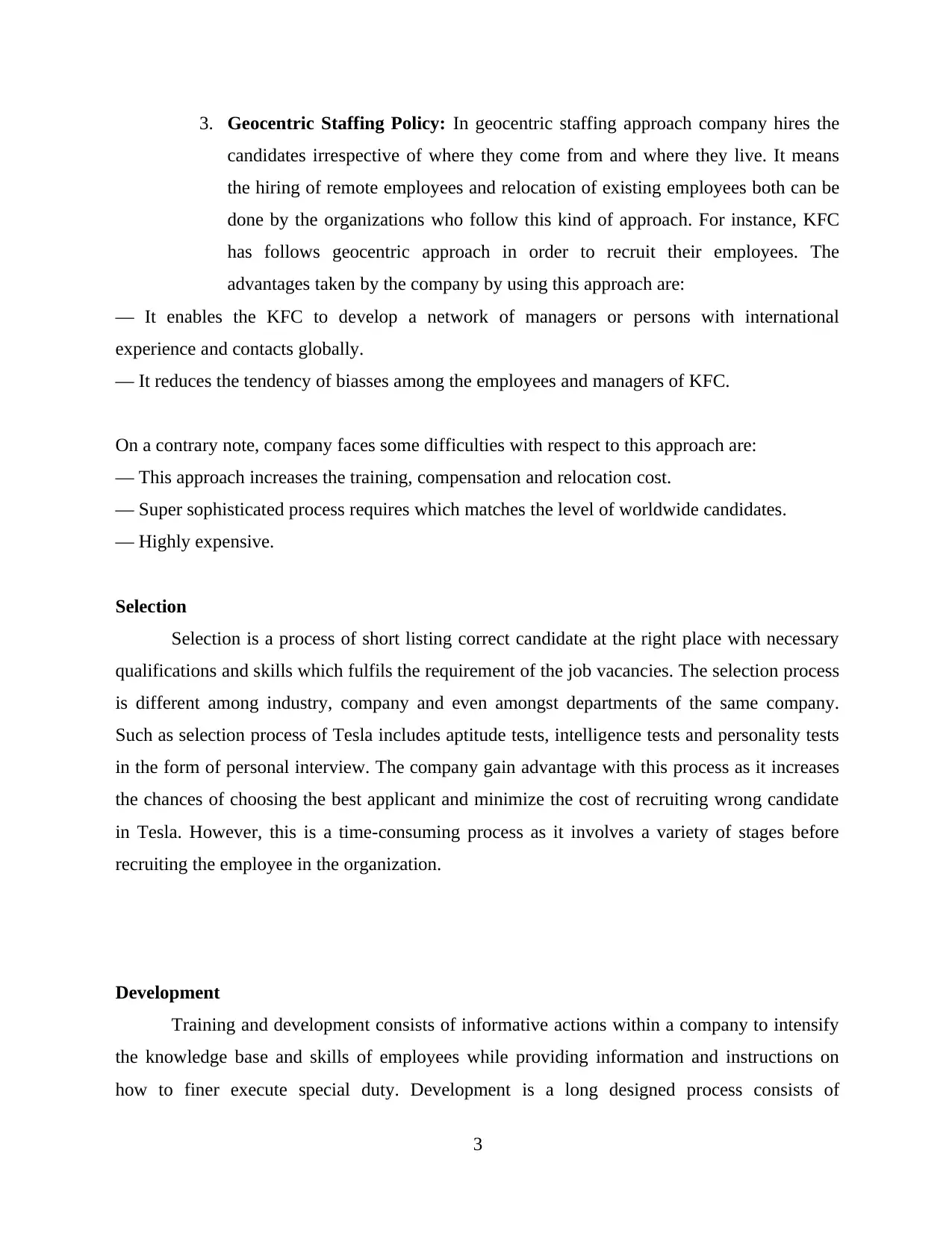
3. Geocentric Staffing Policy: In geocentric staffing approach company hires the
candidates irrespective of where they come from and where they live. It means
the hiring of remote employees and relocation of existing employees both can be
done by the organizations who follow this kind of approach. For instance, KFC
has follows geocentric approach in order to recruit their employees. The
advantages taken by the company by using this approach are:
— It enables the KFC to develop a network of managers or persons with international
experience and contacts globally.
— It reduces the tendency of biasses among the employees and managers of KFC.
On a contrary note, company faces some difficulties with respect to this approach are:
— This approach increases the training, compensation and relocation cost.
— Super sophisticated process requires which matches the level of worldwide candidates.
— Highly expensive.
Selection
Selection is a process of short listing correct candidate at the right place with necessary
qualifications and skills which fulfils the requirement of the job vacancies. The selection process
is different among industry, company and even amongst departments of the same company.
Such as selection process of Tesla includes aptitude tests, intelligence tests and personality tests
in the form of personal interview. The company gain advantage with this process as it increases
the chances of choosing the best applicant and minimize the cost of recruiting wrong candidate
in Tesla. However, this is a time-consuming process as it involves a variety of stages before
recruiting the employee in the organization.
Development
Training and development consists of informative actions within a company to intensify
the knowledge base and skills of employees while providing information and instructions on
how to finer execute special duty. Development is a long designed process consists of
3
candidates irrespective of where they come from and where they live. It means
the hiring of remote employees and relocation of existing employees both can be
done by the organizations who follow this kind of approach. For instance, KFC
has follows geocentric approach in order to recruit their employees. The
advantages taken by the company by using this approach are:
— It enables the KFC to develop a network of managers or persons with international
experience and contacts globally.
— It reduces the tendency of biasses among the employees and managers of KFC.
On a contrary note, company faces some difficulties with respect to this approach are:
— This approach increases the training, compensation and relocation cost.
— Super sophisticated process requires which matches the level of worldwide candidates.
— Highly expensive.
Selection
Selection is a process of short listing correct candidate at the right place with necessary
qualifications and skills which fulfils the requirement of the job vacancies. The selection process
is different among industry, company and even amongst departments of the same company.
Such as selection process of Tesla includes aptitude tests, intelligence tests and personality tests
in the form of personal interview. The company gain advantage with this process as it increases
the chances of choosing the best applicant and minimize the cost of recruiting wrong candidate
in Tesla. However, this is a time-consuming process as it involves a variety of stages before
recruiting the employee in the organization.
Development
Training and development consists of informative actions within a company to intensify
the knowledge base and skills of employees while providing information and instructions on
how to finer execute special duty. Development is a long designed process consists of
3
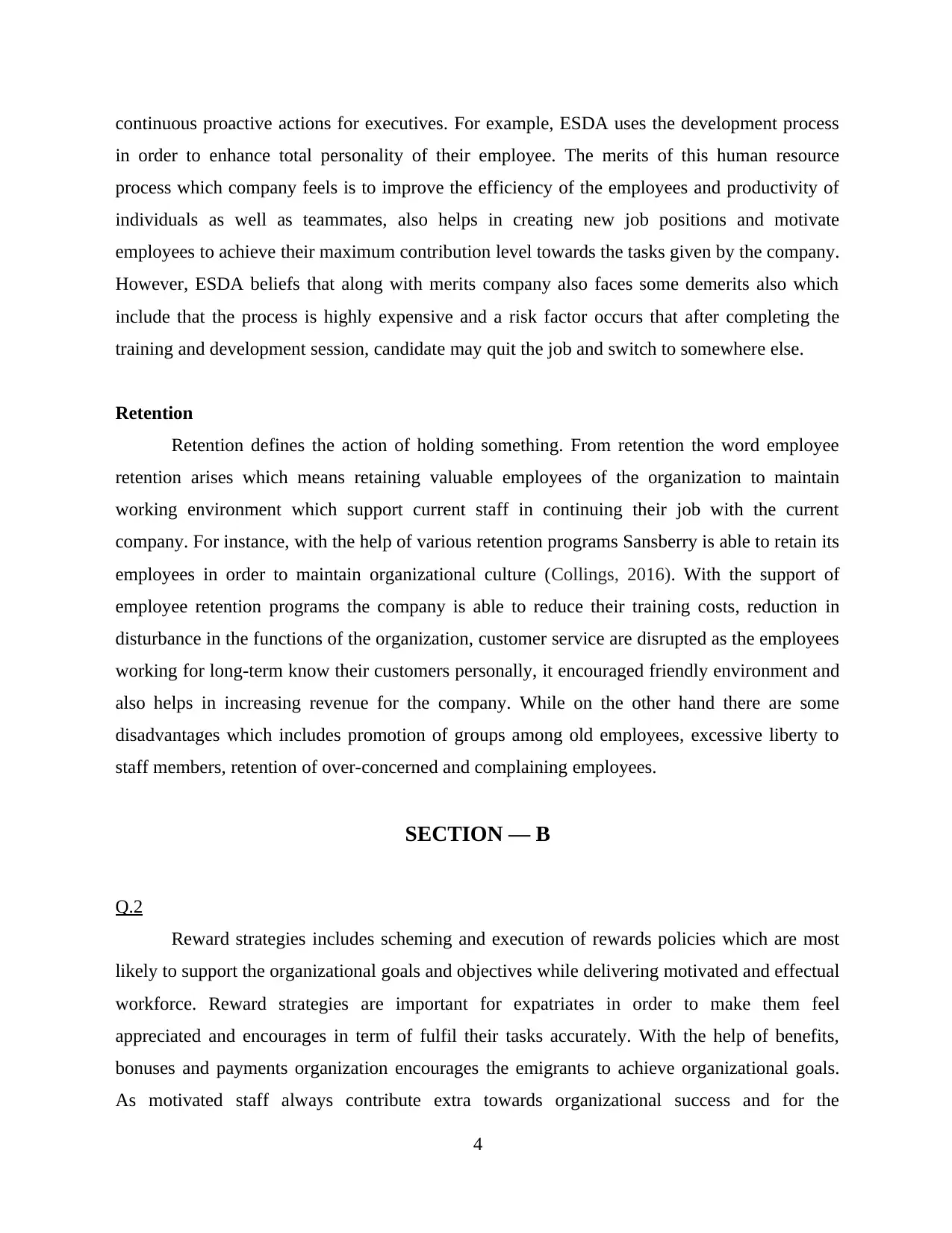
continuous proactive actions for executives. For example, ESDA uses the development process
in order to enhance total personality of their employee. The merits of this human resource
process which company feels is to improve the efficiency of the employees and productivity of
individuals as well as teammates, also helps in creating new job positions and motivate
employees to achieve their maximum contribution level towards the tasks given by the company.
However, ESDA beliefs that along with merits company also faces some demerits also which
include that the process is highly expensive and a risk factor occurs that after completing the
training and development session, candidate may quit the job and switch to somewhere else.
Retention
Retention defines the action of holding something. From retention the word employee
retention arises which means retaining valuable employees of the organization to maintain
working environment which support current staff in continuing their job with the current
company. For instance, with the help of various retention programs Sansberry is able to retain its
employees in order to maintain organizational culture (Collings, 2016). With the support of
employee retention programs the company is able to reduce their training costs, reduction in
disturbance in the functions of the organization, customer service are disrupted as the employees
working for long-term know their customers personally, it encouraged friendly environment and
also helps in increasing revenue for the company. While on the other hand there are some
disadvantages which includes promotion of groups among old employees, excessive liberty to
staff members, retention of over-concerned and complaining employees.
SECTION — B
Q.2
Reward strategies includes scheming and execution of rewards policies which are most
likely to support the organizational goals and objectives while delivering motivated and effectual
workforce. Reward strategies are important for expatriates in order to make them feel
appreciated and encourages in term of fulfil their tasks accurately. With the help of benefits,
bonuses and payments organization encourages the emigrants to achieve organizational goals.
As motivated staff always contribute extra towards organizational success and for the
4
in order to enhance total personality of their employee. The merits of this human resource
process which company feels is to improve the efficiency of the employees and productivity of
individuals as well as teammates, also helps in creating new job positions and motivate
employees to achieve their maximum contribution level towards the tasks given by the company.
However, ESDA beliefs that along with merits company also faces some demerits also which
include that the process is highly expensive and a risk factor occurs that after completing the
training and development session, candidate may quit the job and switch to somewhere else.
Retention
Retention defines the action of holding something. From retention the word employee
retention arises which means retaining valuable employees of the organization to maintain
working environment which support current staff in continuing their job with the current
company. For instance, with the help of various retention programs Sansberry is able to retain its
employees in order to maintain organizational culture (Collings, 2016). With the support of
employee retention programs the company is able to reduce their training costs, reduction in
disturbance in the functions of the organization, customer service are disrupted as the employees
working for long-term know their customers personally, it encouraged friendly environment and
also helps in increasing revenue for the company. While on the other hand there are some
disadvantages which includes promotion of groups among old employees, excessive liberty to
staff members, retention of over-concerned and complaining employees.
SECTION — B
Q.2
Reward strategies includes scheming and execution of rewards policies which are most
likely to support the organizational goals and objectives while delivering motivated and effectual
workforce. Reward strategies are important for expatriates in order to make them feel
appreciated and encourages in term of fulfil their tasks accurately. With the help of benefits,
bonuses and payments organization encourages the emigrants to achieve organizational goals.
As motivated staff always contribute extra towards organizational success and for the
4
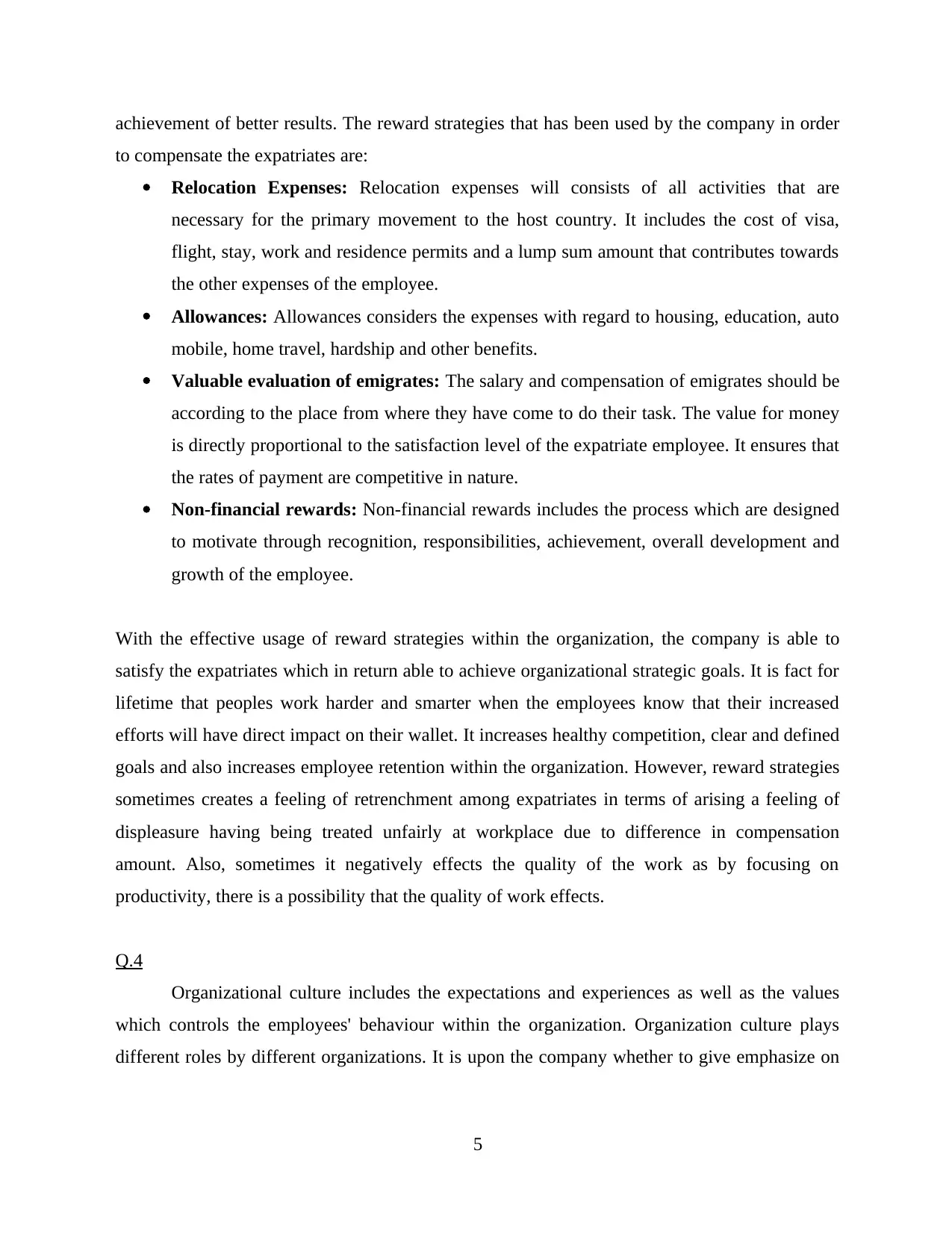
achievement of better results. The reward strategies that has been used by the company in order
to compensate the expatriates are:
Relocation Expenses: Relocation expenses will consists of all activities that are
necessary for the primary movement to the host country. It includes the cost of visa,
flight, stay, work and residence permits and a lump sum amount that contributes towards
the other expenses of the employee.
Allowances: Allowances considers the expenses with regard to housing, education, auto
mobile, home travel, hardship and other benefits.
Valuable evaluation of emigrates: The salary and compensation of emigrates should be
according to the place from where they have come to do their task. The value for money
is directly proportional to the satisfaction level of the expatriate employee. It ensures that
the rates of payment are competitive in nature.
Non-financial rewards: Non-financial rewards includes the process which are designed
to motivate through recognition, responsibilities, achievement, overall development and
growth of the employee.
With the effective usage of reward strategies within the organization, the company is able to
satisfy the expatriates which in return able to achieve organizational strategic goals. It is fact for
lifetime that peoples work harder and smarter when the employees know that their increased
efforts will have direct impact on their wallet. It increases healthy competition, clear and defined
goals and also increases employee retention within the organization. However, reward strategies
sometimes creates a feeling of retrenchment among expatriates in terms of arising a feeling of
displeasure having being treated unfairly at workplace due to difference in compensation
amount. Also, sometimes it negatively effects the quality of the work as by focusing on
productivity, there is a possibility that the quality of work effects.
Q.4
Organizational culture includes the expectations and experiences as well as the values
which controls the employees' behaviour within the organization. Organization culture plays
different roles by different organizations. It is upon the company whether to give emphasize on
5
to compensate the expatriates are:
Relocation Expenses: Relocation expenses will consists of all activities that are
necessary for the primary movement to the host country. It includes the cost of visa,
flight, stay, work and residence permits and a lump sum amount that contributes towards
the other expenses of the employee.
Allowances: Allowances considers the expenses with regard to housing, education, auto
mobile, home travel, hardship and other benefits.
Valuable evaluation of emigrates: The salary and compensation of emigrates should be
according to the place from where they have come to do their task. The value for money
is directly proportional to the satisfaction level of the expatriate employee. It ensures that
the rates of payment are competitive in nature.
Non-financial rewards: Non-financial rewards includes the process which are designed
to motivate through recognition, responsibilities, achievement, overall development and
growth of the employee.
With the effective usage of reward strategies within the organization, the company is able to
satisfy the expatriates which in return able to achieve organizational strategic goals. It is fact for
lifetime that peoples work harder and smarter when the employees know that their increased
efforts will have direct impact on their wallet. It increases healthy competition, clear and defined
goals and also increases employee retention within the organization. However, reward strategies
sometimes creates a feeling of retrenchment among expatriates in terms of arising a feeling of
displeasure having being treated unfairly at workplace due to difference in compensation
amount. Also, sometimes it negatively effects the quality of the work as by focusing on
productivity, there is a possibility that the quality of work effects.
Q.4
Organizational culture includes the expectations and experiences as well as the values
which controls the employees' behaviour within the organization. Organization culture plays
different roles by different organizations. It is upon the company whether to give emphasize on
5
Paraphrase This Document
Need a fresh take? Get an instant paraphrase of this document with our AI Paraphraser
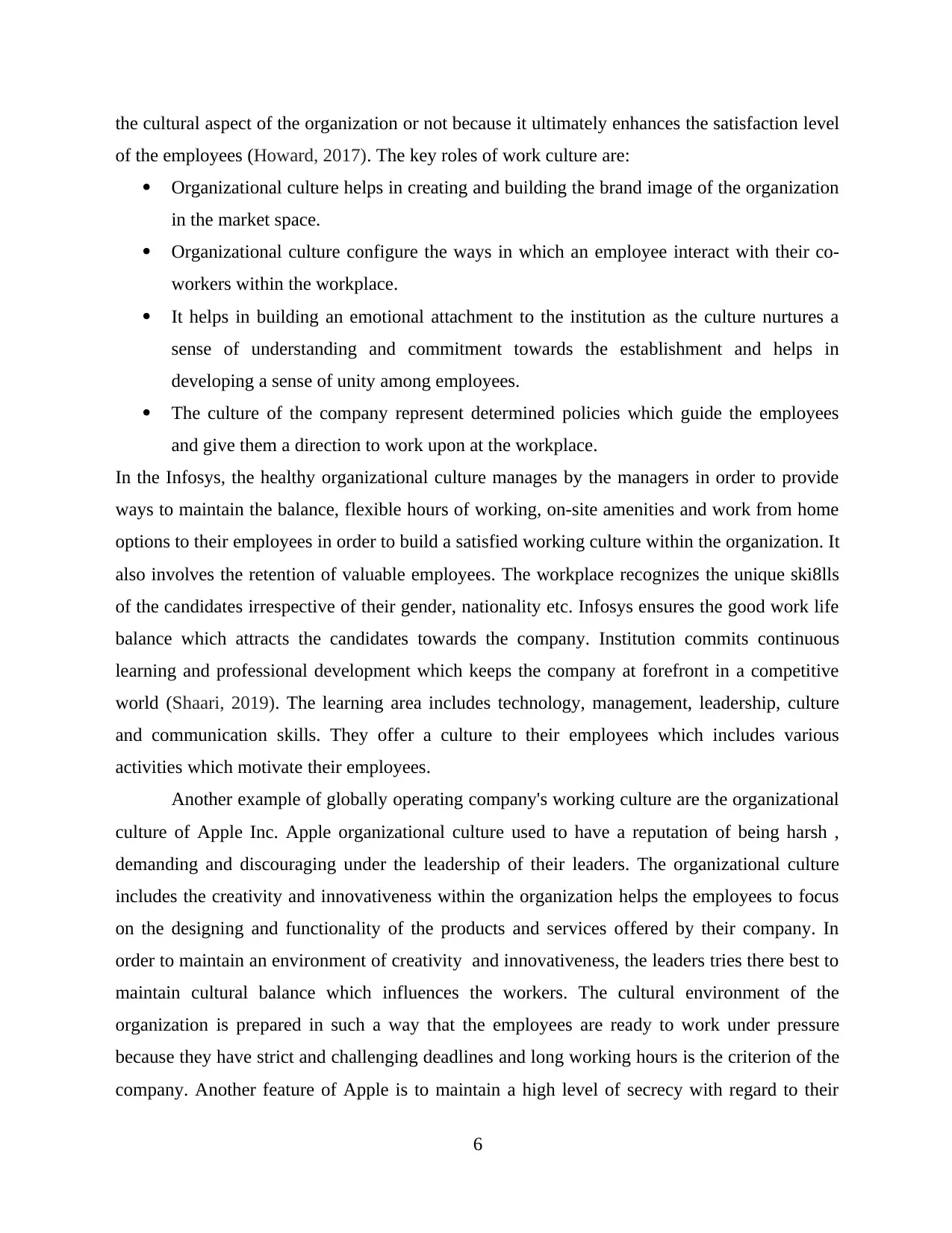
the cultural aspect of the organization or not because it ultimately enhances the satisfaction level
of the employees (Howard, 2017). The key roles of work culture are:
Organizational culture helps in creating and building the brand image of the organization
in the market space.
Organizational culture configure the ways in which an employee interact with their co-
workers within the workplace.
It helps in building an emotional attachment to the institution as the culture nurtures a
sense of understanding and commitment towards the establishment and helps in
developing a sense of unity among employees.
The culture of the company represent determined policies which guide the employees
and give them a direction to work upon at the workplace.
In the Infosys, the healthy organizational culture manages by the managers in order to provide
ways to maintain the balance, flexible hours of working, on-site amenities and work from home
options to their employees in order to build a satisfied working culture within the organization. It
also involves the retention of valuable employees. The workplace recognizes the unique ski8lls
of the candidates irrespective of their gender, nationality etc. Infosys ensures the good work life
balance which attracts the candidates towards the company. Institution commits continuous
learning and professional development which keeps the company at forefront in a competitive
world (Shaari, 2019). The learning area includes technology, management, leadership, culture
and communication skills. They offer a culture to their employees which includes various
activities which motivate their employees.
Another example of globally operating company's working culture are the organizational
culture of Apple Inc. Apple organizational culture used to have a reputation of being harsh ,
demanding and discouraging under the leadership of their leaders. The organizational culture
includes the creativity and innovativeness within the organization helps the employees to focus
on the designing and functionality of the products and services offered by their company. In
order to maintain an environment of creativity and innovativeness, the leaders tries there best to
maintain cultural balance which influences the workers. The cultural environment of the
organization is prepared in such a way that the employees are ready to work under pressure
because they have strict and challenging deadlines and long working hours is the criterion of the
company. Another feature of Apple is to maintain a high level of secrecy with regard to their
6
of the employees (Howard, 2017). The key roles of work culture are:
Organizational culture helps in creating and building the brand image of the organization
in the market space.
Organizational culture configure the ways in which an employee interact with their co-
workers within the workplace.
It helps in building an emotional attachment to the institution as the culture nurtures a
sense of understanding and commitment towards the establishment and helps in
developing a sense of unity among employees.
The culture of the company represent determined policies which guide the employees
and give them a direction to work upon at the workplace.
In the Infosys, the healthy organizational culture manages by the managers in order to provide
ways to maintain the balance, flexible hours of working, on-site amenities and work from home
options to their employees in order to build a satisfied working culture within the organization. It
also involves the retention of valuable employees. The workplace recognizes the unique ski8lls
of the candidates irrespective of their gender, nationality etc. Infosys ensures the good work life
balance which attracts the candidates towards the company. Institution commits continuous
learning and professional development which keeps the company at forefront in a competitive
world (Shaari, 2019). The learning area includes technology, management, leadership, culture
and communication skills. They offer a culture to their employees which includes various
activities which motivate their employees.
Another example of globally operating company's working culture are the organizational
culture of Apple Inc. Apple organizational culture used to have a reputation of being harsh ,
demanding and discouraging under the leadership of their leaders. The organizational culture
includes the creativity and innovativeness within the organization helps the employees to focus
on the designing and functionality of the products and services offered by their company. In
order to maintain an environment of creativity and innovativeness, the leaders tries there best to
maintain cultural balance which influences the workers. The cultural environment of the
organization is prepared in such a way that the employees are ready to work under pressure
because they have strict and challenging deadlines and long working hours is the criterion of the
company. Another feature of Apple is to maintain a high level of secrecy with regard to their
6
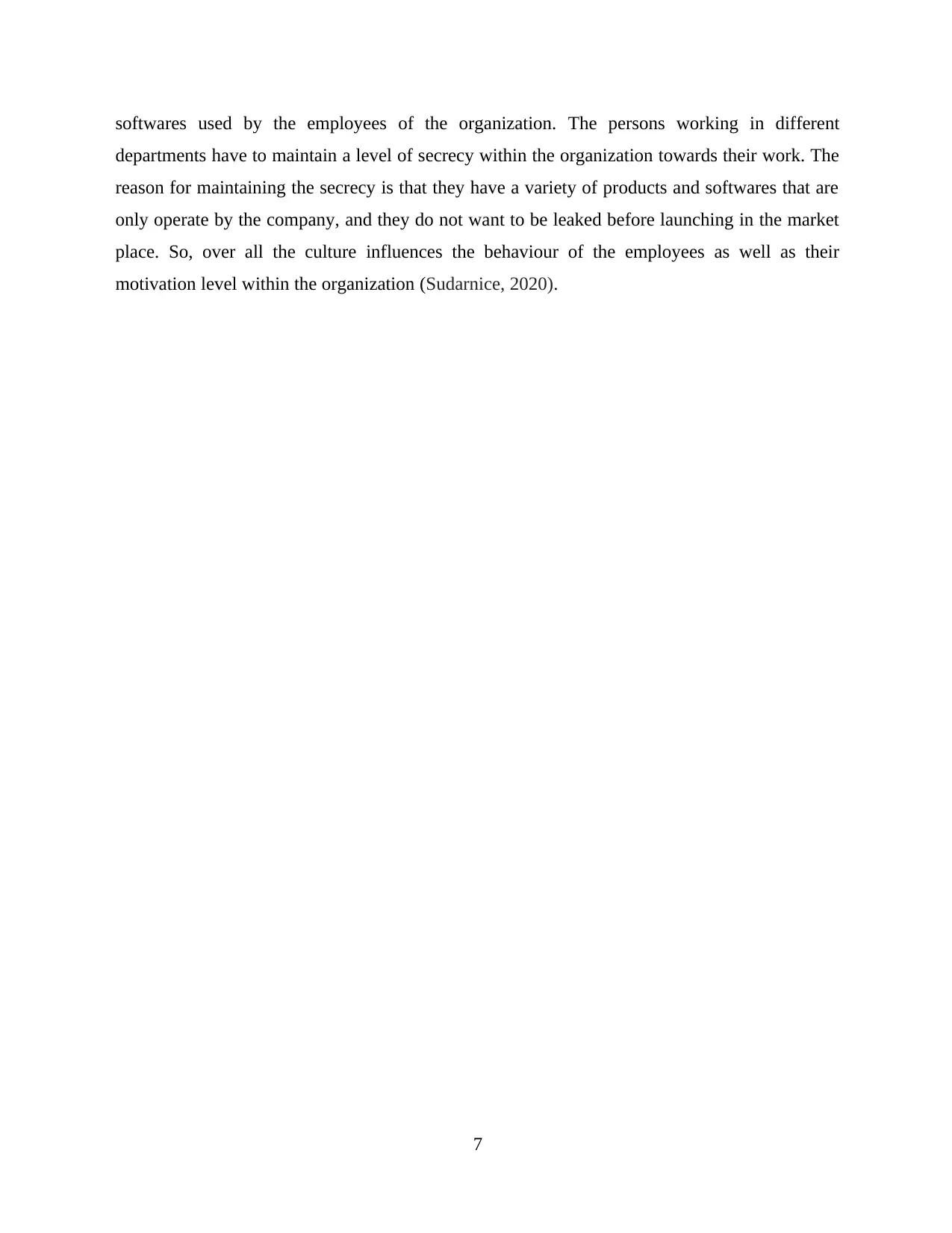
softwares used by the employees of the organization. The persons working in different
departments have to maintain a level of secrecy within the organization towards their work. The
reason for maintaining the secrecy is that they have a variety of products and softwares that are
only operate by the company, and they do not want to be leaked before launching in the market
place. So, over all the culture influences the behaviour of the employees as well as their
motivation level within the organization (Sudarnice, 2020).
7
departments have to maintain a level of secrecy within the organization towards their work. The
reason for maintaining the secrecy is that they have a variety of products and softwares that are
only operate by the company, and they do not want to be leaked before launching in the market
place. So, over all the culture influences the behaviour of the employees as well as their
motivation level within the organization (Sudarnice, 2020).
7
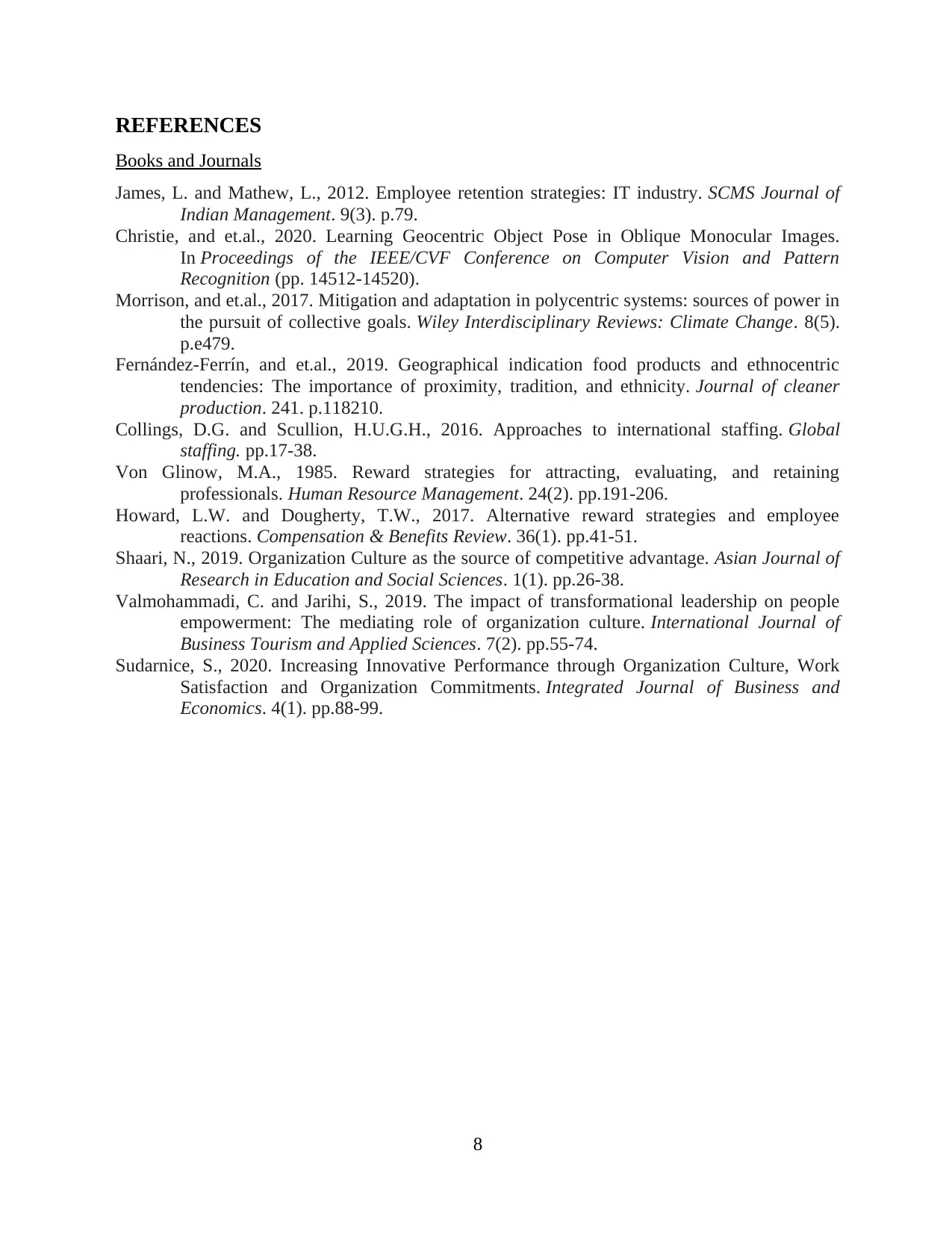
REFERENCES
Books and Journals
James, L. and Mathew, L., 2012. Employee retention strategies: IT industry. SCMS Journal of
Indian Management. 9(3). p.79.
Christie, and et.al., 2020. Learning Geocentric Object Pose in Oblique Monocular Images.
In Proceedings of the IEEE/CVF Conference on Computer Vision and Pattern
Recognition (pp. 14512-14520).
Morrison, and et.al., 2017. Mitigation and adaptation in polycentric systems: sources of power in
the pursuit of collective goals. Wiley Interdisciplinary Reviews: Climate Change. 8(5).
p.e479.
Fernández-Ferrín, and et.al., 2019. Geographical indication food products and ethnocentric
tendencies: The importance of proximity, tradition, and ethnicity. Journal of cleaner
production. 241. p.118210.
Collings, D.G. and Scullion, H.U.G.H., 2016. Approaches to international staffing. Global
staffing. pp.17-38.
Von Glinow, M.A., 1985. Reward strategies for attracting, evaluating, and retaining
professionals. Human Resource Management. 24(2). pp.191-206.
Howard, L.W. and Dougherty, T.W., 2017. Alternative reward strategies and employee
reactions. Compensation & Benefits Review. 36(1). pp.41-51.
Shaari, N., 2019. Organization Culture as the source of competitive advantage. Asian Journal of
Research in Education and Social Sciences. 1(1). pp.26-38.
Valmohammadi, C. and Jarihi, S., 2019. The impact of transformational leadership on people
empowerment: The mediating role of organization culture. International Journal of
Business Tourism and Applied Sciences. 7(2). pp.55-74.
Sudarnice, S., 2020. Increasing Innovative Performance through Organization Culture, Work
Satisfaction and Organization Commitments. Integrated Journal of Business and
Economics. 4(1). pp.88-99.
8
Books and Journals
James, L. and Mathew, L., 2012. Employee retention strategies: IT industry. SCMS Journal of
Indian Management. 9(3). p.79.
Christie, and et.al., 2020. Learning Geocentric Object Pose in Oblique Monocular Images.
In Proceedings of the IEEE/CVF Conference on Computer Vision and Pattern
Recognition (pp. 14512-14520).
Morrison, and et.al., 2017. Mitigation and adaptation in polycentric systems: sources of power in
the pursuit of collective goals. Wiley Interdisciplinary Reviews: Climate Change. 8(5).
p.e479.
Fernández-Ferrín, and et.al., 2019. Geographical indication food products and ethnocentric
tendencies: The importance of proximity, tradition, and ethnicity. Journal of cleaner
production. 241. p.118210.
Collings, D.G. and Scullion, H.U.G.H., 2016. Approaches to international staffing. Global
staffing. pp.17-38.
Von Glinow, M.A., 1985. Reward strategies for attracting, evaluating, and retaining
professionals. Human Resource Management. 24(2). pp.191-206.
Howard, L.W. and Dougherty, T.W., 2017. Alternative reward strategies and employee
reactions. Compensation & Benefits Review. 36(1). pp.41-51.
Shaari, N., 2019. Organization Culture as the source of competitive advantage. Asian Journal of
Research in Education and Social Sciences. 1(1). pp.26-38.
Valmohammadi, C. and Jarihi, S., 2019. The impact of transformational leadership on people
empowerment: The mediating role of organization culture. International Journal of
Business Tourism and Applied Sciences. 7(2). pp.55-74.
Sudarnice, S., 2020. Increasing Innovative Performance through Organization Culture, Work
Satisfaction and Organization Commitments. Integrated Journal of Business and
Economics. 4(1). pp.88-99.
8
1 out of 10
Related Documents
Your All-in-One AI-Powered Toolkit for Academic Success.
+13062052269
info@desklib.com
Available 24*7 on WhatsApp / Email
![[object Object]](/_next/static/media/star-bottom.7253800d.svg)
Unlock your academic potential
© 2024 | Zucol Services PVT LTD | All rights reserved.





